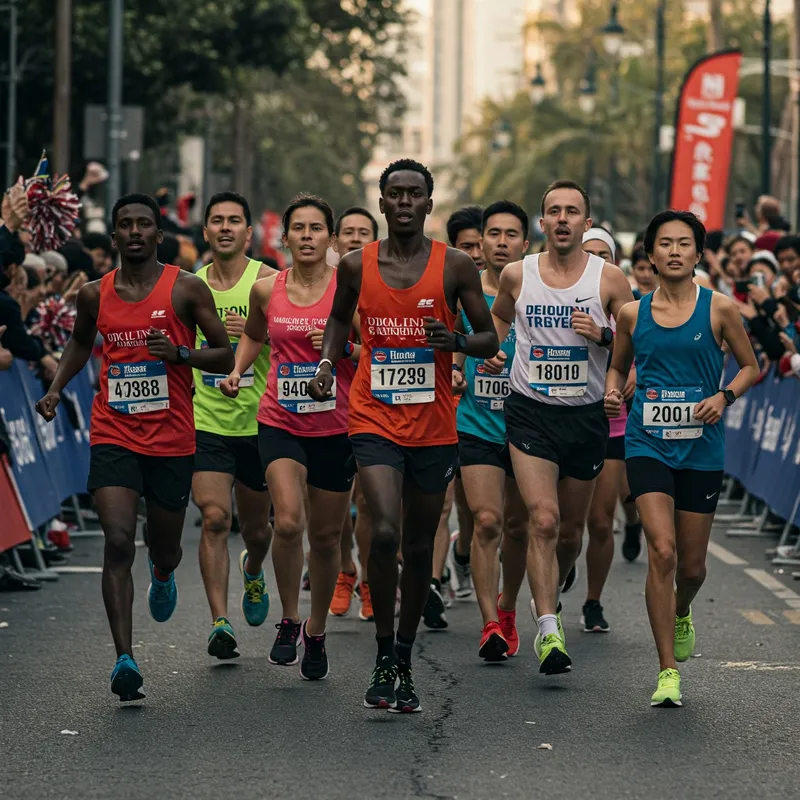We often marvel at the seemingly superhuman feats of elite marathon runners. Beyond their incredible training regimens and mental fortitude, there’s a natural curiosity about their physical attributes. While previous posts explored the average height, weight, and body composition typical of elite marathoners, looking at individual legends provides fascinating real-world context and reveals the variations that exist even at the pinnacle of the sport.
How do the physical stats of marathon icons like Eliud Kipchoge or Paula Radcliffe stack up? Let’s examine the reported height and weight profiles of some of the most renowned names in marathon history, drawing on data compiled in sports science analyses.
Eliud Kipchoge – The GOAT
Widely regarded as the Greatest Of All Time (GOAT) in marathon running, Eliud Kipchoge’s consistency and boundary-pushing performances (including the first sub-two-hour marathon, albeit under special conditions) make his physique a subject of great interest.
- Height: Reports vary slightly, listing him at 167 cm (approx. 5′ 6″), 170 cm (approx. 5′ 7″), and 168 cm (approx. 5′ 6″). The most common figures suggest he stands around 167-168 cm (5′ 6″).
- Weight: His reported weight also shows some variation, listed as 57 kg (approx. 126 lbs) and 52 kg (approx. 115 lbs) in different sources or at different times (e.g., 2016 vs. 2021). This likely reflects normal fluctuations during training cycles. His typical race weight is generally considered to be in the lower end of this range, around 52 kg.
Kipchoge’s measurements align well with the profile of the typical elite male marathoner – relatively modest height combined with exceptionally low body weight, optimized for running efficiency.
Paula Radcliffe – Former World Record Holder
For years, Paula Radcliffe held the women’s world record with a time that stood as a monumental achievement. Her physical profile offers an interesting comparison point.
- Height: Radcliffe is consistently reported as being 173 cm (approx. 5′ 8″) tall.
- Weight: Her competition weight is consistently listed as 54 kg (approx. 119 lbs).
Notably, Radcliffe is significantly taller than the average elite female marathoner (who typically average around 160-163 cm or 5’3″-5’4″). This demonstrates that while trends exist, elite success isn’t confined to a single height bracket. However, her weight remains extremely low for her height, underscoring the importance of leanness regardless of stature.
Other Legendary Female Runners
Data exists for several other iconic female marathoners, showcasing a range of physiques within the elite ranks:
- Ingrid Kristiansen: Another dominant force in her era, Kristiansen is listed at 169 cm (approx. 5′ 7″) and 50 kg (approx. 110 lbs). Like Radcliffe, she was taller than the female average but exceptionally light.
- Shalane Flanagan: The celebrated American marathoner stands at 165 cm (approx. 5′ 5″) and weighs around 48 kg (approx. 106 lbs). Her measurements are closer to the typical profile for elite female runners.
- Mary Keitany: Known for her incredible speed and multiple major marathon victories, Keitany’s weight is reported as an exceptionally low 42 kg (approx. 93 lbs). While height data wasn’t consistently available in the analyzed sources, her weight highlights the extreme leanness often seen at the very top.
- Tirunesh Dibaba: A legend on both track and road, Dibaba’s stats are listed as 166 cm (approx. 5′ 5″) (or ~165 cm in some reports) and 50 kg (approx. 110 lbs), fitting quite squarely within the typical elite female runner profile.
What Can We Learn from Individual Profiles?
Examining these individual cases reinforces several key points:
- Averages are Baselines: While average heights and weights provide a useful benchmark, individual champions show that there is a range within which success is possible.
- Variation Exists: Factors beyond just height and weight contribute to greatness. Athletes like Paula Radcliffe prove that being taller than average isn’t necessarily a barrier to world-class performance if other factors (like running economy and low body fat) are optimized.
- Leanness is Consistent: The overwhelming common denominator across almost all these legends, regardless of height, is extremely low body weight and body fat percentage. This powerfully reinforces the principles of optimal body composition discussed previously – minimizing non-functional weight is critical.
- Inspiration, Not Replication: While it’s fascinating to see the stats of the greats, runners should focus on optimizing their own physique healthily, rather than trying to perfectly emulate a specific champion’s build.
Conclusion
The physical profiles of marathon legends like Kipchoge, Radcliffe, and others offer a captivating glimpse into the builds that have dominated the sport. While individual heights vary – Kipchoge fitting the shorter mold, Radcliffe standing taller – the universal theme is exceptional leanness and low body weight relative to height. These real-world examples vividly illustrate the importance of optimal body composition, driven by low body fat, in achieving the running economy necessary to excel over 26.2 grueling miles. They are truly giants of the road, not necessarily in stature, but in their incredible endurance and finely tuned running physiques.

About the Author
Lost Pace is an ultramarathon runner, shoe-tester and the founder of umit.net. Based year-round in Türkiye’s rugged Kaçkar Mountains, he has logged 10,000 + km of technical trail running and completed multiple 50 K–100 K ultras.
Blending mountain grit with data, Lost analyses power (CP 300 W), HRV and nutrition to craft evidence-backed training plans. He has co-written 260 + long-form guides on footwear science, recovery and endurance nutrition, and is a regular beta-tester of AI-driven coaching tools.
When he isn’t chasing PRs or testing midsoles, you’ll find him sharing peer-reviewed research in plain English to help runners train smarter, stay healthier and finish stronger.
Ultrarunner · Data geek · Vegan athlete

